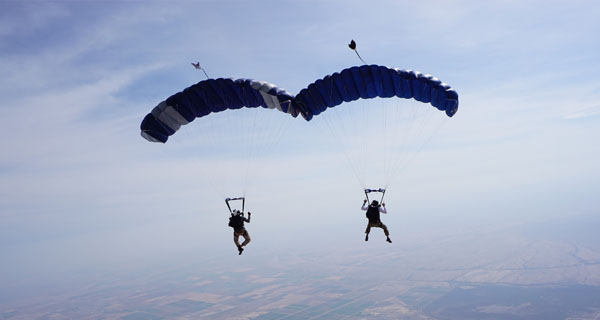Skip down to:
Extended canopy time, coupled with personalized one-on-one instruction, students will cover relative work essentials and collision avoidance, along with plenty of air time during high altitude hop and pops. An AXIS coach will lead you showing canopy handling techniques, relative targeting and specific formations. They will ride with you and personally coach you through each maneuver, covering each aspect and your responsibility as a flight leader and wing-man.
All courses in this program can be customized to suit your needs. We can accommodate most time and budget parameters – even full day and multi-day courses (on-site or off-site)!
In-Air Skills Course Tier 3
«Formation Flying»

Photo by Niklas Daniel.
… introduces you to flying in close proximity to another canopy pilot. In doing so, you will learn new ways to predict what another person will do under canopy, and how to non-verbally communicate with them. In addition, you will learn how your canopy reacts to inputs from your toggles, rear risers, and front risers relative to another canopy.
By learning to fly next to another canopy, you will also become more efficient at avoiding other canopies, as the same techniques apply.
In-Air Skills Course Tier 2
«Dynamic Formations»

Photo by Max Haim.
… builds on the formation flying introduction by adding higher levels of complexity. Here you will learn the different rolls and responsibilities of being a flight leader or wingman. You will learn to fly specific formations through coordinated turns, and learning to change positions relative to another canopy pilot.
In-Air Skills Course Tier 2
«Team Landings»

Photo by Kay Robinson.
Take your formation flying skills to the next level with team landings. Learn to fly in close proximity to one another all the way to touch down. Must be proficient at dynamic formations. High performance canopy not required.
In-Air Skills Course Tier 1
«1-on-1 CRW»

Photo by Niklas Daniel.
… offers individuals a chance to learn how to dock on another canopy pilot. Once a pilot is proficient at flying dynamic formations, that skills is fine-tuned to the point where you can fly precise enough to make controlled contact with another pilot. Various canopy formations and slots are explored.
In-Air Skills Course Tier 1
«XRW Canopy Pilot»

Photo by Dan Dupuis.
Once a high level of skill has been demonstrated in Tier 2: Dynamic Formations, it is possible to enter the realm of XRW (eXtreme Relative Work).
Prerequisites
- Wing loading of 2.8 or greater.
- Operating a full RDS (stowed in less than 20 seconds).
- Proficient at flying and landing your parachute (off site if necessary).
- Canopy piloting competition experience is not required, but preferred.
Available Merits

In-Air Canopy Skills: Formation Flying
Recipient has demonstrated the knowledge and skills to safely and effectively fly in close proximity to another canopy pilot.
How this Merit is Earned
Achieved prerequisite merits: USPA B-License Canopy Proficiency.
In addition, recipient has demonstrated the following to the satisfaction of an AXIS Coach™: a) Understanding of canopy collision avoidance and emergency proceedures, b) Exit and flying strategies to effectively join and fly in close proximity to another canopy pilot, c) Bumping end cells, d) Ability to effectively chase and catch up to another canopy pilot using all canopy inputs and control ranges e) Safely and effectively navigate through another canopy pilot's wake, f) Ability to plan and execute a flight pattern that allows participants to return to the DZ safely.

In-Air Canopy Skills: Dynamic Formations
Recipient has demonstrated the knowledge and skills to fly in close proximity to another canopy pilot while engaging in dynamic formations.
How this Merit is Earned
Achieved prerequisite merits: In-air Canopy Skills - Formation Flying.
In addition, recipient has demonstrated the following to the satisfaction of an AXIS Coach™: a) Pitch-out & Re-join maneuver, b) Maintaining position within a formation while following the flight leader through a heading change, c) effectively transitioning from one preplanned formation type to another, including on and off-level.

In-Air Canopy Skills: Team Landings
Recipient has demonstrated the knowledge and skills to safely and effectively land in close proximity with another canopy pilot.
How this Merit is Earned
Achieved prerequisite merits: Advanced Accuracy and In-air Canopy Skills - Dynamic Formations.
In addition, recipient has demonstrated the following to the satisfaction of an AXIS Coach™: a) Lead a canopy formation through a predicatble landing pattern, touching down on target, b) Ability to effectivly follow a flight leader less than 60 feet away in flight to a predeclared target c) Touching down no more than three seconds after the flight leader.

In-Air Canopy Skills: 1–on–1 CRW
Recipient has demonstrated the knowledge and skill to perform canopy relative work (CRW) at an entry level.
How this Merit is Earned
Achieved prerequisite merits: In-air Canopy Skills - Formation Flying and In-air Canopy Skills: Dynamic Formations.
In addition, recipient has demonstrated the following to the satisfaction of an AXIS Coach™: a) understanding of canopy-collision avoidance and emergency proceedures, b) equipment choices specific to CRW, c) building and piloting a two-stack formation, d) building a 2-way compressed stack.

In-Air Canopy Skills: XRW Canopy Pilot
Recipient has demonstrated the knowledge and skills of a proficient extreme relative work (XRW) Canopy Pilot.
How this Merit is Earned
Achieved prerequisite merit: In-air Canopy Skills - Dynamic Formations, In-air Canopy Skills - 1-on1 CRW, Canopy Piloting Tier 1, and RDS Endorsement.
In addition, recipient has demonstrated the following to the satisfaction of an AXIS Coach™: a) ability to safely fly a parachute at a wing loading of 2.8 or greater, b) ability to detach and stow an RDS in 20 seconds or less, c) ability to plan and execute a flight pattern that allows participants to return to the DZ safely, d) has taken at least two stationary docks on a single XRW jump in a controlled manner.

